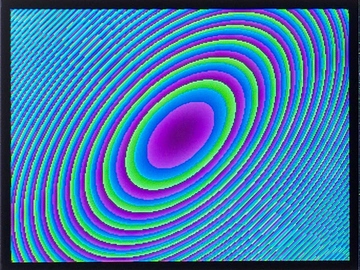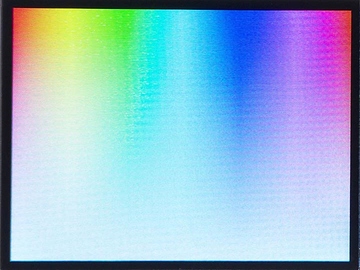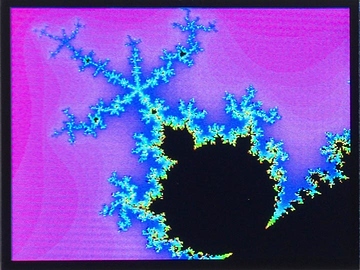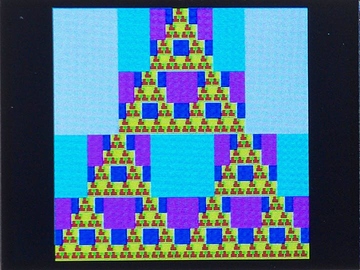Here are some examples to demonstrate the use of the graphics extensions, currently available in the RISC-V version of uLisp that supports the Sipeed MAiX range of RISC-V boards.
RGB utility
These routines make use of the following rgb utility to define a colour from its RGB components:
(defun rgb (r g b)
(logior (ash (logand r #xf8) 8) (ash (logand g #xfc) 3) (ash b -3)))
Each of the parameters r, g, and b should be an integer from 0 to 255. For example, to define orange you could use:
(defvar *orange* (rgb 255 128 0))
Coloured ellipses
This simple demo displays a series of coloured ellipses:
(defun plot ()
(dotimes (xx 320)
(let ((x (- xx 160)))
(dotimes (yy 240)
(let* ((y (- yy 120))
(f (truncate (+ (* x (+ x y)) (* y y)) 8)))
(draw-pixel xx yy (rgb (+ f 160) f (+ f 80))))))))
It plots the value of x^2 + y^2 + xy as a function of x and y.
HSV utility
This routine allows you to specify colours in the alternative HSV colour system (also called HSB); see HSL and HSV.
(defun hsv (h s v)
(let* ((chroma (* v s))
(x (* chroma (- 1 (abs (- (mod (/ h 60) 2) 1)))))
(m (- v chroma))
(i (truncate h 60))
(params (list chroma x 0 0 x chroma))
(r (+ m (nth i params)))
(g (+ m (nth (mod (+ i 4) 6) params)))
(b (+ m (nth (mod (+ i 2) 6) params))))
(rgb (round (* r 255)) (round (* g 255)) (round (* b 255)))))
It’s useful because, for particular fixed values of s and v, you can generate a range of different colours of similar brightness and saturation simply by varying the h parameter.
It takes the following parameters:
- h is the hue, which can be from 0 to 359, representing degrees around a colour circle.
- s is the saturation, which can be from 0, representing white, to 1.0, representing 100% saturation.
- v is the value, which can be from 0, representing black, to 1.0, representing 100% brightness.
The following routine generates the plot shown above of hue horizontally against saturation vertically, with value = 100%:
(defun plot ()
(set-rotation 2)
(fill-screen)
(dotimes (x 320)
(dotimes (y 240)
(draw-pixel x y (hsv (/ (* x 360) 320) (/ y 240) 1)))))
Mandelbrot set
This popular fractal function generates complex detail however far you zoom in to it; see Mandelbrot set.
For each point (x, y) the function repeatedly applies a transformation to the complex number represented by x + iy, and counts the number of iterations before the size of the value exceeds 2.
The number of iterations is plotted as a different colour, using the above hsv routine, or black if the function hasn’t diverged after 80 iterations:
(defun mandelbrot (x0 y0 scale)
(set-rotation 2)
(fill-screen)
(dotimes (y 240)
(let ((b0 (+ (/ (- y 120) 120 scale) y0)))
(dotimes (x 320)
(let* ((a0 (+ (/ (- x 160) 120 scale) x0))
(c 80) (a a0) (b b0) a2)
(loop
(setq a2 (+ (- (* a a) (* b b)) a0))
(setq b (+ (* 2 a b) b0))
(setq a a2)
(decf c)
(when (or (> (+ (* a a) (* b b)) 4) (zerop c)) (return)))
(draw-pixel x y (if (plusp c) (hsv (* 359 (/ c 80)) 1 1) 0)))))))
The parameters x0 and y0 are the coordinates of the centre of the plot, and scale specifies the scale factor. To plot the whole Mandelbrot set call:
(mandelbrot -0.5 0 1)
The plot shown above zooms in on a detail, and was obtained with:
(mandelbrot -0.53 -0.61 11)
On a MAiX board at the default clock speed it took 127 s.
Sierpinski curve
This is a recursively-defined curve. It starts with a triangle constructed from three squares; then each square is replaced by a triangle of smaller squares, and so on. Each generation is shown in a different colour:
(defun sierpinski (x0 y0 size gen)
(when (plusp gen)
(let ((s (ash size -1))
(n (1- gen)))
(fill-rect x0 y0 size size (col gen))
(sierpinski (+ x0 (ash s -1)) y0 s n)
(sierpinski x0 (+ y0 s) s n)
(sierpinski (+ x0 s) (+ y0 s) s n))))
The following function col defines a different colour for each value of n from 0 to 7:
(defun col (n)
(rgb (* (logand n 1) 160) (* (logand n 2) 80) (* (logand n 4) 40)))
Finally, this function draw draws the above plot showing 7 generations:
(defun draw ()
(set-rotation 2)
(fill-screen)
(sierpinski 40 0 240 7))




